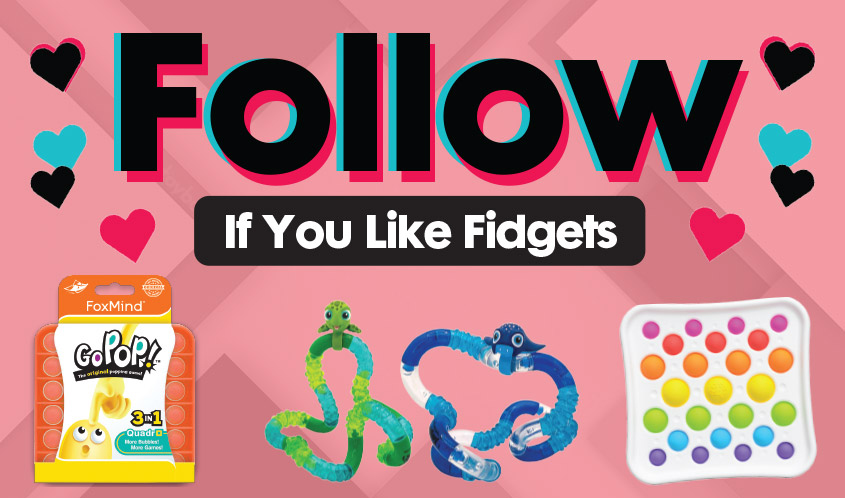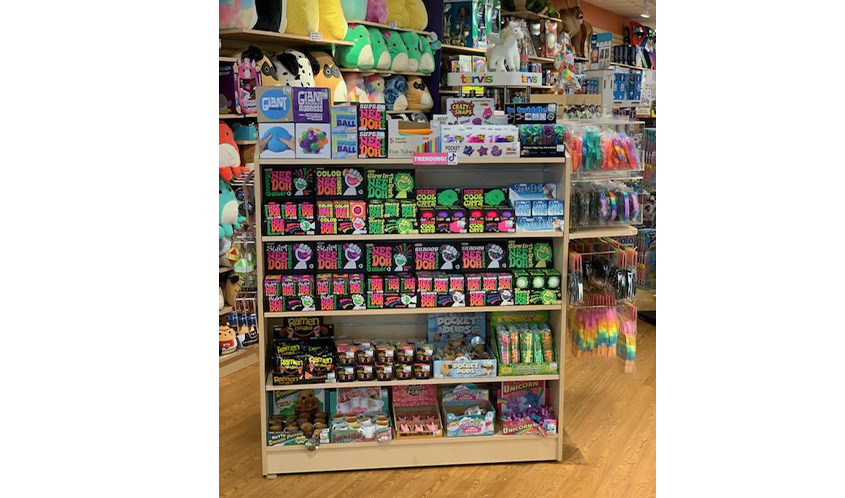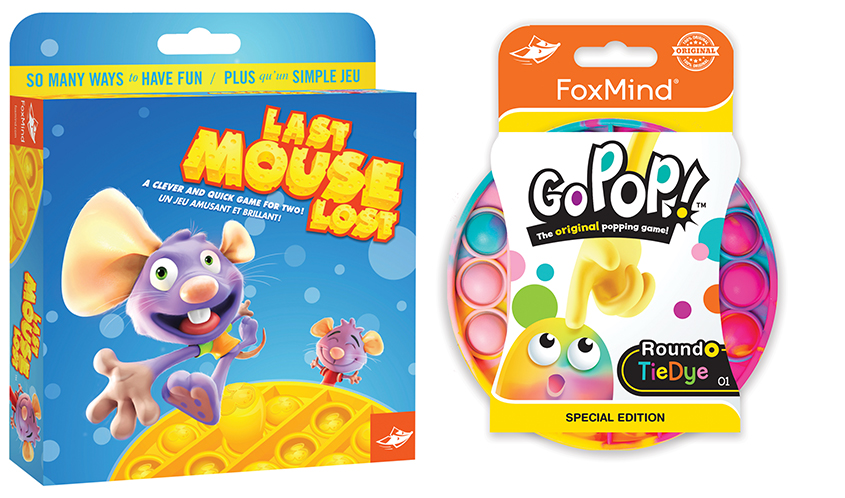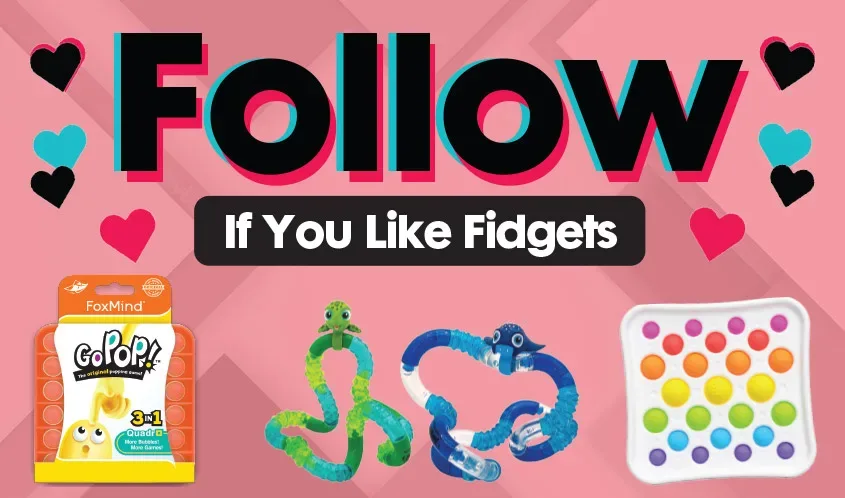
Back in January, when kids started coming into the Learning Express Toys of Cahaba Heights in Birmingham, Alabama, and asking for “fidget toys,” owner Melissa McCollum felt a bit of déjà vu a la 2017. It’s hard to forget the fidget spinner and cube craze that hit about four years ago, which arrived almost overnight and seemed to disappear almost as quickly.
But, this time, McCollum says, the increasing popularity of fidget toys is a larger, more widespread trend that has, in her experience, produced much larger sales numbers than the spinner craze. The current fidget toy market offers a much wider range of products: tangles, fidget pea pods, marble mesh, silicone poppers, squishy balls — and the list goes on. The product offering is plentiful enough to fill a dedicated section in her store … and get the store’s TikTok page to more than 600,000 followers and more than 5 million likes.
TikTok, the fast-growing, video-based social media app, has been an undeniably important factor in this fidget toy resurgence. “TikTok and social media are actually driving the fidget trend,” McCollum says. “We post TikToks about other toys and Squishmallows frequently, but the fidget toys are getting the most views right now.”
In fact, one of the store’s recent fidget videos got more than 5 million views in one day. McCollum says that the staffers who make the TikTok content, Jessica and Kaitlyn, often get recognized by kids who come into the store after school.

A quick search for “fidget toys” on the app further proves the popularity of this specific trend, with hundreds of videos showcasing fidget toy collections, loud fidgets, quiet fidgets, homemade fidgets, and endless additional, fidget-based topics. There are even dozens of popular accounts entirely dedicated to fidget toy content.
One creator, who prefers to go by her username @charxfidgets, originally heard about fidget toys last summer and purchased her first pack of fidgets on Amazon in September. Since starting her current fidget-focused TikTok account in February, she has amassed more than 680,000 followers and 9.3 million likes. Her account is filled with videos that showcase her different fidgets, dream fidgets, fidget trades with her sister, fidget hauls from local stores, and more. Some of the content is as simple as taking a new fidget out of its packaging for an unboxing demonstration, while other videos involve responding to fan comments and setting interactive challenges for her fanbase.
“The excitement of getting new fidgets is the best feeling,” she says. She also credits the larger fidget community on TikTok with inspiring her video content and introducing her to new types of fidgets. “I base most of my videos from creators on my For You page. If I see a video that I think would be fun, I save it to use for when I want to film a video.”
Some of @charxfidgets’ personal favorite fidgets include Nee-Dohs from Schylling, Simpl Dimpl from Fat Brain Toys, and popping fidgets, a popular fidget toy with silicone bubbles that kids can press in, then flip the toy over and press the bubbles back the other way, almost like never-ending bubble wrap.

While this fidget has become incredibly popular in the past year, FoxMind Games originally started producing and selling this type of silicone popping toy back in 2013, as a game called Last Mouse Lost. The game — yellow, with mice printed on the bubbles — performed well, but by 2019, FoxMind decided to rebrand the product. The company renamed it Last One Lost; started offering it in yellow, teal, and purple; and changed the packaging so that consumers could try popping some of the bubbles before buying it.
According to JC Dorais, who manages marketing for FoxMind, the team had no idea that their game had gone viral on TikTok until influencers started reaching out last summer and asking about Last One Lost. When Dorais logged on to TikTok, he was shocked to find people interacting with the toy in so many ways — from playing the actual game or popping the bubbles to more creative uses, such as making ice cubes or creating ASMR videos.
“Even in the rules of 2013, we were saying that if you have other creative ways to use the item, come back to us, be imaginative, and find different ways of using it,” Dorais says.
Now, more than seven years later, that’s exactly what is happening.
This marked somewhat of a pivot for the FoxMind team, who had little experience in creating collectible, impulse toys — or dealing with the many imitations and counterfeits that soon started flooding the marketplace. The original Last One Lost stands out, Dorais says, because the game rules extend the play value. Later this year, FoxMind plans to release special editions, including tie-dye, glow-in-the-dark, and UV-color-changing versions of Last One Lost.
As someone directly experiencing the current, TikTok-induced fidget renaissance, Dorais knows why this type of toy is gaining so much traction right now, both on and off of social media. For those looking to create TikTok content, he explains, fidgets are a very accessible genre. Not only are fidgets relatively inexpensive to purchase, but they are also easy to talk about.
“An 8-year-old could talk as well as an adult about a fidget. You don’t need to have a master’s degree to talk about fidgets,” he says. “And on TikTok what you see is that since it’s very easy to talk about, anyone can do a video of popping bubbles. You don’t need any kind of skills really to play this. You just pop and enjoy and have fun with it.”
However, this social media success has dovetailed in a year when kids (and, as @charxfidgets will tell you, anyone of any age) are needing and seeking the psychological benefits that fidget toys can offer. As kids and teens spend more time indoors and in front of their screens, and as they experience anxiety induced by the COVID-19 pandemic, Dorais and McCollum both believe that fidget toys provide an outlet to relieve stress.
“I think that the fidgets, in a way, are helping people to be grounded and focused,” Dorais says. “So when I’m playing with this, I’m not looking at my screen. I’m actually looking at my item and very into it. So the physicality of it, the fact that it’s cheap, the fact that you can carry it around … I think that’s the secret behind the fidgets right now.”
This article was originally published in the May 2021 edition of the Toy Book. Click here to read the full issue!

